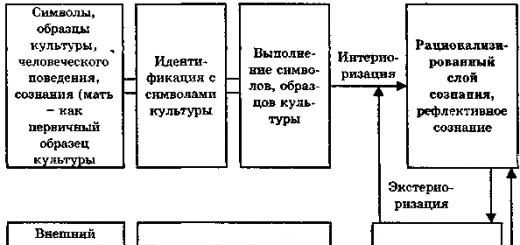Chemical properties a-amino acids are determined, in the very general case, the presence of carboxyl and amine groups on the same carbon atom. The specificity of the side functional groups of amino acids determines the differences in their reactivity and the individuality of each amino acid. The properties of side functional groups come to the fore in the molecules of polypeptides and proteins, i.e. after the amine and carboxyl groups did their job, they formed a polyamide chain.
So, the chemical properties of the amino acid fragment itself are divided into reactions of amines, reactions carboxylic acids and properties due to their mutual influence.
The carboxyl group manifests itself in reactions with alkalis - forming carboxylates, with alcohols - forming esters, with ammonia and amines - forming acid amides, a-amino acids are quite easily decarboxylated when heated and under the action of enzymes (Scheme 4.2.1).
This reaction is of great physiological importance, since its implementation in vivo leads to the formation of the corresponding biogenic amines, which perform a number of specific functions in living organisms. When histidine is decarboxylated, histamine is formed, which has a hormonal effect. In the human body, it is in a bound form, is released during inflammatory and allergic reactions, anaphylactic shock, causes capillary expansion, contraction of smooth muscles, sharply increases secretion of hydrochloric acid in the stomach.
Also, by the decarboxylation reaction, together with the hydroxylation reaction of the aromatic ring, another biogenic amine, serotonin, is formed from tryptophan. It is found in humans in intestinal cells in platelets, in the poisons of coelenterates, mollusks, arthropods and amphibians, and is found in plants (bananas, coffee, sea buckthorn). Serotonin performs mediator functions in the central and peripheral nervous systems, affects the tone of blood vessels, increases the resistance of capillaries, increases the number of platelets in the blood (Scheme 4.2.2).
The amino group of amino acids manifests itself in reactions with acids, forming ammonium salts, acylated
Scheme 4.2.1
Scheme 4.2.2

and alkylates upon interaction with acid halides and haloalkyls, with aldehydes it forms Schiff bases, and with nitrous acid, like conventional primary amines, it forms the corresponding hydroxy derivatives, in this case hydroxy acids (Scheme 4.2.3).
Scheme 4.2.3

The simultaneous participation of the amino group and the carboxyl function in chemical reactions quite varied. a-Amino acids form complexes with ions of many divalent metals - these complexes are built with the participation of two amino acid molecules per metal ion, while the metal forms two types of bonds with ligands: the carboxyl group gives with the metal ionic bond, and the amino group participates with its unshared electron pair, which is coordinated to the free orbitals of the metal (donor-acceptor bond), giving the so-called chelate complexes (Scheme 4.2.4, the metals are arranged in a row according to the stability of the complexes).
Since both acidic and basic functions are present in the amino acid molecule, the interaction between them is inevitable - it leads to the formation of an internal salt (zwitterion). Since it is the salt of a weak acid and a weak base, aqueous solution it will hydrolyze easily, i.e. the system is balanced. In the crystalline state, amino acids have a purely zwitterionic structure, hence the high levels of these substances (Scheme 4.2.5).
Scheme 4.2.4

Scheme 4.2.5

The ninhydrin reaction has great importance for the detection of amino acids in their qualitative and quantitative analysis. Most amino acids react with ninhydrin, releasing the corresponding aldehyde, while the solution turns into an intense blue-violet color (nm), solutions orange color(nm) give only proline and hydroxyproline. The reaction scheme is rather complicated and its intermediate steps are not entirely clear; the colored reaction product is called "Ruemann's violet" (Scheme 4.2.6).
Diketopiperazines are formed by heating free amino acids, and preferably by heating their esters.
Scheme 4.2.6

The reaction product can be determined by its structure - as a pyrazine heterocycle derivative, by the reaction scheme - as a cyclic double amide, since it is formed by the interaction of amino groups with carboxyl functions according to the nucleophilic substitution scheme (Scheme 4.2.7).
The formation of polyamides of a-amino acids is a variation of the above-described reaction for the formation of dikepiperazines, and the one
Scheme 4.2.7

Scheme 4.2.8

variety, for the sake of which Nature probably created this class of compounds. The essence of the reaction is the nucleophilic attack of the amino group of one α-amino acid on the carboxyl group of the second α-amino acid, while the amine group of the second amino acid sequentially attacks the carboxyl group of the third amino acid, etc. (diagram 4.2.8).
The result of the reaction is a polyamide or (called in relation to the chemistry of proteins and protein-like compounds) a polypeptide. Accordingly, the -CO-NH- fragment is called a peptide unit or a peptide bond.
Amino acids are the main building material of any living organism. By their nature, they are the primary nitrogenous substances of plants, which are synthesized from the soil. The structure of and and amino acids depend on their composition.
Amino acid structure
Each of its molecule has carboxyl and amine groups, which are connected to the radical. If an amino acid contains 1 carboxyl and 1 amino group, its structure can be denoted by the formula below.

Amino acids that have 1 acid and 1 alkaline group are called monoaminomonocarboxylic. In organisms are also synthesized and whose functions determine 2 carboxyl groups or 2 amine groups. Amino acids containing 2 carboxyl and 1 amino groups are called monoaminodicarboxylic, and those containing 2 amine and 1 carboxyl group are called diaminomonocarboxylic.
They also differ in the structure of the organic radical R. Each of them has its own name and structure. Hence and various functions amino acids. It is the presence of acidic and alkaline groups that ensures its high reactivity. These groups connect amino acids and form a polymer - a protein. Proteins are also called polypeptides because of their structure.
Amino acids as a building material
A protein molecule is a chain of tens or hundreds of amino acids. Proteins differ in composition, quantity and order of amino acids, because the number of combinations of 20 components is almost infinite. Some of them have the entire composition of essential amino acids, while others do without one or more. Separate amino acids, the structure, the functions of which are similar to the proteins of the human body, are not used as food, as they are poorly soluble and do not break down the gastrointestinal tract. These include the proteins of nails, hair, wool or feathers.
The functions of amino acids cannot be overestimated. These substances are the main food in the diet of people. What is the function of amino acids? They increase the growth of muscle mass, help strengthen joints and ligaments, restore damaged body tissues and participate in all processes that occur in the human body.

Essential amino acids
Only from supplements or food products can be obtained Functions in the process of forming healthy joints, strong muscles, beautiful hair are very significant. These amino acids include:
- phenylalanine;
- lysine;
- threonine;
- methionine;
- valine;
- leucine;
- tryptophan;
- histidine;
- isoleucine.
Functions of essential amino acids
These bricks perform the most important functions in the work of every cell of the human body. They are imperceptible as long as they enter the body in sufficient quantities, but their deficiency significantly impairs the functioning of the whole organism.
- Valine renews muscles, serves as an excellent source of energy.
- Histidine improves blood composition, promotes muscle recovery and growth, improves joint function.
- Isoleucine helps produce hemoglobin. Controls the amount of sugar in the blood, increases a person's energy, endurance.
- Leucine strengthens the immune system, monitors the level of sugar and leukocytes in the blood. If the level of leukocytes is too high: it lowers them and connects the body's reserves to eliminate inflammation.
- Lysine helps calcium absorption, which forms and strengthens bones. Helps the production of collagen, improves hair structure. For men, this is an excellent anabolic, as it builds muscle and increases male strength.
- Methionine normalizes the digestive system and liver. Participates in the breakdown of fats, removes toxicosis in pregnant women, and has a beneficial effect on hair.
- Threonine improves the functioning of the digestive tract. Increases immunity, participates in the creation of elastin and collagen. Threonine prevents the deposition of fat in the liver.
- Tryptophan is responsible for human emotions. Produces serotonin - the hormone of happiness, thereby normalizes sleep, improves mood. It tames the appetite, has a beneficial effect on the heart muscle and arteries.
- Phenylalanine serves as a transmitter of signals from nerve cells to the brain of the head. Improves mood, suppresses unhealthy appetite, improves memory, increases susceptibility, reduces pain.
A deficiency of essential amino acids leads to stunting, metabolic disorders, and a decrease in muscle mass.

Non-essential amino acids
These are amino acids, the structure and functions of which are produced in the body:
- arginine;
- alanine;
- asparagine;
- glycine;
- proline;
- taurine;
- tyrosine;
- glutamate;
- serine;
- glutamine;
- ornithine;
- cysteine;
- carnitine.
Functions of non-essential amino acids
- Cysteine eliminates toxic substances, is involved in the creation of skin and muscle tissues, and is a natural antioxidant.
- Tyrosine reduces physical fatigue, speeds up metabolism, eliminates stress and depression.
- Alanine serves for muscle growth, is a source of energy.
- increases metabolism and reduces the formation of ammonia at high loads.
- Cystine eliminates pain in case of injury to the ligaments and joints.
- responsible for brain activity, during prolonged physical exertion goes into glucose, producing energy.
- Glutamine restores muscles, improves immunity, speeds up metabolism, enhances brain function and creates growth hormone.
- Glycine is essential for muscle function, fat breakdown, blood pressure and blood sugar stabilization.
- Carnitine moves fatty acids into cells where they are broken down to release energy, resulting in excess fat being burned and energy being generated.
- Ornithine produces growth hormone, participates in the process of urination, breaks down fatty acids, and helps the production of insulin.
- Proline provides the production of collagen, it is necessary for ligaments and joints.
- Serine boosts immunity and produces energy, needed for a fast metabolism fatty acids and muscle growth.
- Taurine breaks down fat, raises the body's resistance, synthesizes bile salts.
Protein and its properties
Proteins, or proteins, are macromolecular compounds containing nitrogen. The concept of "protein", first designated by Berzelius in 1838, comes from the Greek word and means "primary", which reflects the leading value of proteins in nature. The variety of proteins makes it possible for existence huge amount living beings: from bacteria to the human body. There are significantly more of them than other macromolecules, because proteins are the foundation of a living cell. They make up approximately 20% of the mass of the human body, more than 50% of the dry mass of the cell. Such a variety of proteins is due to the properties of twenty different amino acids that interact with each other and create polymer molecules.

An outstanding property of proteins is the ability to independently create a specific spatial structure characteristic of a particular protein. Proteins are biopolymers with peptide bonds. For chemical composition proteins tend to have a constant average nitrogen content of approximately 16%.
Life, as well as the growth and development of the body, is impossible without the function of protein amino acids to build new cells. Proteins cannot be replaced by other elements, their role in the human body is extremely important.
Functions of proteins
The need for proteins lies in the following functions:
- it is necessary for growth and development, as it acts as the main building material for the creation of new cells;
- controls metabolism, during which energy is released. After eating, the metabolic rate increases, for example, if the food consists of carbohydrates, the metabolism accelerates by 4%, if from proteins - by 30%;
- regulate in the body, due to its hydrophilicity - the ability to attract water;
- strengthen the immune system by synthesizing antibodies that protect against infection and eliminate the threat of disease.

Products - protein sources
Muscles and the human skeleton consist of living tissues that not only function, but are also updated throughout life. They recover from damage, retain their strength and durability. To do this, they require well-defined nutrients. Food provides the body with the energy needed for all processes, including muscle function, tissue growth and repair. And protein in the body is used both as a source of energy and as a building material.

Therefore, it is very important to observe its daily use in food. Protein-rich foods: chicken, turkey, lean ham, pork, beef, fish, shrimp, beans, lentils, bacon, eggs, nuts. All these foods provide the body with protein and provide the energy needed for life.
Amino acids are organic amphoteric compounds. They contain two functional groups of the opposite nature in the molecule: an amino group with basic properties and a carboxyl group with acidic properties. Amino acids react with both acids and bases:
H 2 N -CH 2 -COOH + HCl → Cl [H 3 N-CH 2 -COOH],
H 2 N -CH 2 -COOH + NaOH → H 2 N-CH 2 -COONa + H 2 O.
When amino acids are dissolved in water, the carboxyl group splits off a hydrogen ion, which can join the amino group. In this case, an internal salt is formed, the molecule of which is a bipolar ion:
H 2 N-CH 2 -COOH + H 3 N -CH 2 -COO -.
Acid-base conversion of amino acids into various environments can be represented by the following general scheme:

Aqueous solutions of amino acids have a neutral, alkaline or acidic environment, depending on the number of functional groups. So, glutamic acid forms an acidic solution (two groups -COOH, one -NH 2), lysine - alkaline (one group -COOH, two -NH 2).
Like primary amines, amino acids react with nitrous acid, while the amino group turns into a hydroxo group, and the amino acid into a hydroxy acid:
H 2 N-CH(R)-COOH + HNO 2 → HO-CH(R)-COOH + N 2 + H 2 O
Measuring the volume of released nitrogen allows you to determine the amount of amino acid ( Van Slyke method).
Amino acids can react with alcohols in the presence of hydrogen chloride gas to become ester(more precisely, into the hydrochloric salt of ether):
H 2 N-CH (R) -COOH + R'OH H 2 N-CH (R) -COOR' + H 2 O.
Esters of amino acids do not have a bipolar structure and are volatile compounds.
The most important property of amino acids is their ability to condense to form peptides.
Qualitative reactions.
1) All amino acids are oxidized by ninhydrin

with the formation of products, colored in blue-violet color. The imino acid proline gives a yellow color with ninhydrin. This reaction can be used for the quantitative determination of amino acids by the spectrophotometric method.
2) When aromatic amino acids are heated with concentrated nitric acid, nitration occurs benzene ring and compounds are formed that are colored in yellow. This reaction is called xantoprotein(from Greek xanthos - yellow).
The acid-base properties of amino acids are associated with the presence in their structure of two ionizable groups - carboxyl and amino groups, therefore, amino acids can exhibit the properties of both acids and bases, i.e. they are amphoteric compounds. In the crystalline state and in aqueous solutions, -amino acids exist as bipolar ions, also called zwitterions. The ionic structure determines some features of the properties of -amino acids: high melting point (200-300С), non-volatility, solubility in water and insolubility in non-polar organic solvents. The solubility of amino acids in water is related to their absorption and transport in the body. The ionization of amino acid molecules depends on the pH of the solution. For monoaminomonocarboxylic acids, the dissociation process has the following form:
In strongly acidic solutions, amino acids are present as positive ions, while in alkaline solutions they are present as negative ions.
The acid-base properties of amino acids can be explained on the basis of the Brønsted-Lowry theory of acids and bases. Fully protonated -amino acid (cationic form) from the standpoint of the Bronsted theory is a dibasic acid containing two acid groups: an undissociated carboxyl group (-COOH) and a protonated amino group (NH 3), which are characterized by the corresponding values of pK 1 and pK 2.
The pKa values for amino acids are determined from titration curves. Consider the alanine titration curve (Fig. 1).

Rice. 1 – curves obtained by titration of 0.1 M alanine solution with 0.1 M HCl(a) solution and 0.1 M NaOH solution (b).
It follows from the alanine titration curve that the carboxyl group has pK 1 = 2.34, and the protonated amino group pK 2 = 9.69. At pH = 6.02, alanine exists as a bipolar ion when the total electric charge of the particle is 0. At this pH value, the alanine molecule is electrically neutral. This pH value is called the isoelectric point and is referred to as pH iet or pI. For monoaminomonocarboxylic acids, the isoelectric point is calculated as the arithmetic mean of two pK values. For example, for alanine, it is equal to:
рI= ½(рК 1 + рК 2) = ½(2.34 + 9.69) = 6.02
At a pH value exceeding the isoelectric point, the amino acid is negatively charged, and at a pH value below the pI amino acid carries a total positive charge. For example, at pH = 1.0, all alanine molecules exist in the form of ions

with a total charge of +1. At pH = 2.34, when there is a mixture of equal amounts of ions

total charge = +0.5. Similarly, one can predict the sign and magnitude of the net charge for any other amino acid at any pH value.
Amino acids with an ionizable group in the radical have more complex titration curves, consisting of 3 sections corresponding to three possible stages of ionization, and therefore they have three pK values (pK 1, pK 2 and pK R). The ionization of acidic amino acids, such as aspartic, consists of the following successive stages:

The isoelectric points of such amino acids are also determined by the presence of an ionizable radical group, along with -amino and -carboxyl groups. For monoaminodicarboxylic acids, the isoelectric points are shifted to the acidic pH region and are defined as the arithmetic mean between the pK values for two carboxyl groups (pIaspartic acid = 2.97). For basic amino acids, pIs are shifted to the alkaline region and are calculated as the arithmetic mean between pK values for two protonated amino groups (pIlysine = 9.74).
The acid-base properties of amino acids are used for the separation and subsequent identification of amino acids by electrophoresis and ion-exchange chromatography. Both of these methods are based on differences in the sign and magnitude of the total electric charge at a given pH value.
Among nitrogen-containing organic matter there are connections with a dual function. Particularly important of these are amino acids.
About 300 different amino acids are found in the cells and tissues of living organisms, but only 20 ( α-amino acids ) of them serve as links (monomers) from which the peptides and proteins of all organisms are built (therefore they are called protein amino acids). The sequence of these amino acids in proteins is encoded in the nucleotide sequence of the corresponding genes. The remaining amino acids are found both in the form of free molecules and in bound form. Many of the amino acids are found only in certain organisms, and there are some that are found in only one of the great many described organisms. Most microorganisms and plants synthesize the amino acids they need; animals and humans are not capable of forming the so-called essential amino acids obtained from food. Amino acids are involved in the metabolism of proteins and carbohydrates, in the formation of compounds important for organisms (for example, purine and pyrimidine bases, which are an integral part of nucleic acids), are part of hormones, vitamins, alkaloids, pigments, toxins, antibiotics, etc.; some amino acids serve as intermediaries in the transmission of nerve impulses.
Amino acids- organic amphoteric compounds, which include carboxyl groups - COOH and amino groups -NH 2 .
Amino acids can be considered as carboxylic acids, in the molecules of which the hydrogen atom in the radical is replaced by an amino group.
CLASSIFICATION
Amino acids are classified according to structural features.1. Depending on relative position amino and carboxyl groups of amino acids are divided into α-, β-, γ-, δ-, ε- etc.
2. Depending on the number of functional groups, acidic, neutral and basic are distinguished.
3. By the nature of the hydrocarbon radical, they distinguish aliphatic(fat) aromatic, sulfur-containing and heterocyclic amino acids. The above amino acids belong to the fatty series.
An example of an aromatic amino acid is para-aminobenzoic acid:
An example of a heterocyclic amino acid is tryptophan, an essential α-amino acid.
NOMENCLATURE
According to the systematic nomenclature, the names of amino acids are formed from the names of the corresponding acids by adding the prefix amino and indicating the location of the amino group in relation to the carboxyl group. The numbering of the carbon chain from the carbon atom of the carboxyl group.
For example:
Another method of constructing amino acid names is also often used, according to which the prefix is added to the trivial name of the carboxylic acid amino indicating the position of the amino group by the letter of the Greek alphabet.
Example:
For α-amino acidsR-CH(NH2)COOH
Which play an extremely important role in the life processes of animals and plants, trivial names are used.
Table.
|
Amino acid |
abbreviated designation |
The structure of the radical (R) |
|
Glycine |
Gly (Gly) |
H- |
|
Alanine |
Ala (Ala) |
CH3- |
|
Valine |
Val (Val) |
(CH 3) 2 CH - |
|
Leucine |
Leu (Leu) |
(CH 3) 2 CH - CH 2 - |
|
Serene |
Ser (Ser) |
OH-CH2- |
|
Tyrosine |
Tyr (Tyr) |
HO - C 6 H 4 - CH 2 - |
|
Aspartic acid |
Asp (Asp) |
HOOC–CH2- |
|
Glutamic acid |
Glu (Glu) |
HOOC-CH2-CH2- |
|
Cysteine |
Cys (Cys) |
HS-CH2- |
|
Asparagine |
Asn (Asn) |
O \u003d C - CH 2 - │ NH2 |
|
Lysine |
Lys (Liz) |
NH 2 - CH 2 - CH 2 - CH 2 - |
|
Phenylalanine |
Phen |
C 6 H 5 - CH 2 - |
If an amino acid molecule contains two amino groups, then its name uses the prefixdiamino, three groups of NH 2 - triamino- etc.
Example:
The presence of two or three carboxyl groups is reflected in the name by the suffix – diovaya or -triic acid:
isomerism
1. Isomerism of the carbon skeleton
2. Isomerism of the position of functional groups
3. Optical isomerism
α-amino acids, except for glycine NH 2-CH 2 -COOH.
PHYSICAL PROPERTIES
Amino acids are crystalline substances with high (above 250°C) melting points, which differ little in individual amino acids and are therefore uncharacteristic. Melting is accompanied by the decomposition of matter. Amino acids are highly soluble in water and insoluble in organic solvents, which makes them similar to non organic compounds. Many amino acids have a sweet taste.
RECEIVING
3. Microbiological synthesis. Known microorganisms that in the process of life produce α - amino acids of proteins.
CHEMICAL PROPERTIES
Amino acids are amphoteric organic compounds, they are characterized by acid-base properties.
I . General properties
1. Intramolecular neutralization → a bipolar zwitterion is formed:
Aqueous solutions are electrically conductive. These properties are explained by the fact that amino acid molecules exist in the form of internal salts, which are formed due to the transfer of a proton from the carboxyl to the amino group:
zwitterion
Aqueous solutions of amino acids have a neutral, acidic or alkaline environment, depending on the number of functional groups.
APPLICATION
1) amino acids are widely distributed in nature;
2) amino acid molecules are the building blocks of which all plant and animal proteins are built; amino acids necessary for the construction of body proteins, humans and animals receive as part of food proteins;
3) amino acids are prescribed for severe exhaustion, after heavy operations;
4) they are used to feed the sick;
5) amino acids are necessary as a remedy for certain diseases (for example, glutamic acid is used for nervous diseases, histidine for stomach ulcers);
6) some amino acids are used in agriculture for feeding animals, which positively affects their growth;
7) are of technical importance: aminocaproic and aminoenanthic acids form synthetic fibers - nylon and enanth.
ON THE ROLE OF AMINO ACIDS
Finding in nature and the biological role of amino acids
Finding in nature and the biological role of amino acids










